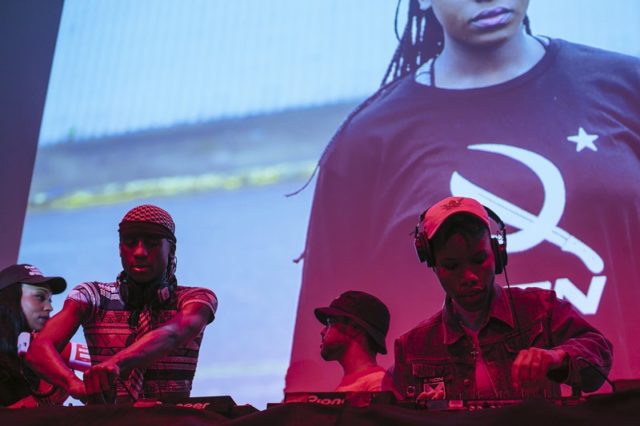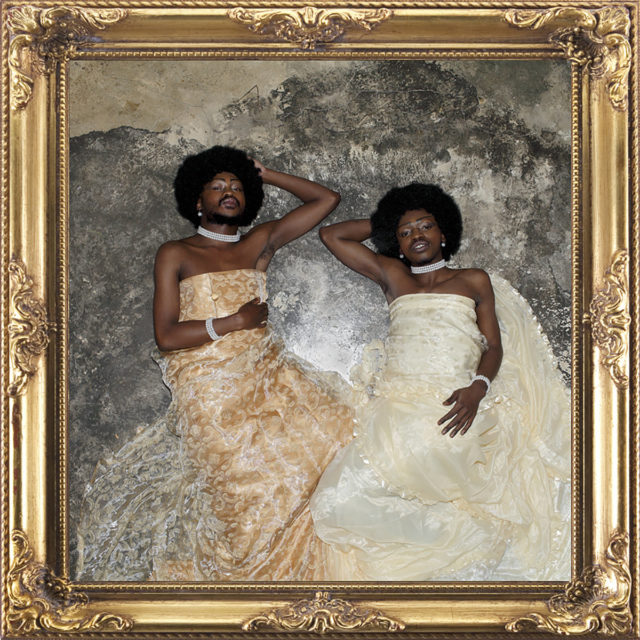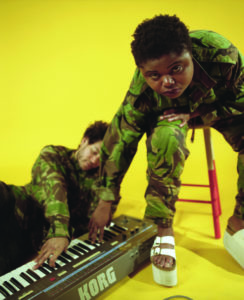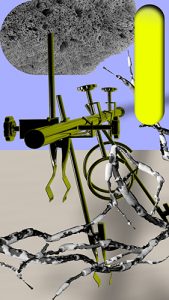Over the last three years, NON have been generating boundary-defying work and significant attention. Formed in 2014 by artists Chino Amobi, nkisi (Melika Ngombe Kolongo) and ANGEL-HO (Angelo Antonio Valerio), the multinational collective consists of pan-diasporic artists primarily using sound and performance as weaponized vehicles of expression. NON’s conceptual premise is the direct articulation of a radical praxis of black liberatory politics through an acute interrogation of hegemonic dichotomies and simulated categorizations. The collective work can be viewed as a psycho-geographical account of the contemporary diasporic experience. Loosely organized and horizontally distributed, the collective has quickly grown to include formal and informal contributions from the likes of Lisbon-based producer Bonaventure (Soraya Lutangu), Brooklyn performer Embaci, Zimbabwean artist Farai, living in London, South African duo FAKA, and most recently Berlin-based choreographer Ligia Lewis. Together they span their influence across multidirectional disciplines.

The mythology of NON lies in its brazen effort to utilize the language of domination, ‘exorcised’ nationalist rhetoric, and striking, militant aesthetic markers to deterritorialize and re-terretorialize cultural production in order to create new contexts and new spaces for meaning. NON Quarterly, a publication of multidisciplinary works by various artists of the diaspora offers a therapeutic space for voicing resistance and radical effects. NON collaborators are often referred to as ‘NON citizens,’ at once highlighting their ‘otherness’ and orienting their bodies into an antagonistic community that defies homogeneity. The name NON inherently presupposes a negation; a negation against predetermined, embodied power structures existing within prescriptive categorization that define the boundaries of subjectivity. Doing so in the context of contemporary art, advertising and sonic production, the collective and individual production of NON citizens negate any sense of prescribed conditions that structure these artistic productions.
For the event NON: Legacy Systems at the New Museum, the collective presented video work that incorporated visual branding reminiscent of corporate and nationalist strategies. NON’s well-designed, unmistakable visual signifiers, often appropriate communist iconography, like the hammer and sickle placed below the NON emblem, as well as other revolutionary symbols. The performances and accompanying video constituted a body of work that, according to the press release, “create a space for a concept of borderless ‘NON citizenry’ that aligns with their mission to challenge binaries and boundaries across virtual and physical realms.” Furthermore, they are meant to be examined and “considered with respect to fashion, the readymade, utopian communities, institutional histories, and social choreographies.”

Members of NON work within loosely distributed virtual and non-virtual networks — in fact nkisi, ANGEL-HO and Chino Amobi met through Facebook and Soundcloud. Coincidentally, the performance component at New Museum happened to be where the UK, US and South Africa-based founders met and performed together as a trio outside of online networks. NON operates more like a situational methodology or attitude more than institutional ideology with hierarchical presuppositions. Their message and creative production seeps fluidly through the margins of prescriptive constructs, engulfing the complexly layered matrices of machinic power.
The stakes in this purposeful resistance are, as a result, quite high and dire, offering no room for vacillation or ambivalence. Success in this cause-and-effect experiment is thus graded on the metrics of the collective’s effectiveness in — to borrow Ranciere’s description of theatrical emancipation — appropriating the relationship to self lost in a systematic process of separation, while bridging that gap through “new, intellectually adventurous” communion. Separation in this sense is the separation and alienation experienced by ‘othered’ bodies. The content and context of production of NON is not entirely removed from the geographies of capitalism, since it takes place in corporately-mediated networks and spaces. NON citizens choose to operate within these conditions in order to make visible the invisible consonants and dissonances structuring topologies of capitalism in relation to tangible systems such as spectacle, finance, immigration, and citizenship. Embodied experiences within these spheres of power are unpacked and made accessible for the purpose of radical self-determination.

Nowhere is this more evident than in the music and performances by members of the NON collective. With what can only be described as Deleuzian alchemy, nkisi melds polyrhythmic, syncopated drum styles and high-tempo orchestration of West African hiplife, Ivorian zoblazo, and Congolese soukous with the discordant textures of Dutch gabber and Belgian hardcore rave. Amobi’s 2016 release Airport Music For Black Folk, recorded during a residency in Berlin, takes its nominative influence from Brian Eno’s Music for Airports. The EP, released through the NON-WORLDWIDE label, consists of seven compositions: ‘London,’ ‘London II,’ ‘Malmo,’ ‘Milan,’ ‘Warszawa,’ ‘Berlin,’ and ‘Rotterdam.’ Sonically, it’s a liturgical requiem channeling and mediating the collective memories of traumas and anxieties resulting from the African diaspora.
Amobi’s use of harsh, confrontational soundscapes, paired with occasional snippets of audio from terminal announcements, critically examines the trauma associated with movement across borders, the airport as hegemonic marketplace, as well as its position as a ritual space for becoming ‘other.’ These peripheral, often taken-for-granted movements and coded gestures serve as a lens for accessing and assessing institutional difference. Airport Music For Black Folk is thus a narrative trace of not only Amobi’s psycho-geographic drift through these spaces, but also the historicity of displacement.
Set up as a theatrical stage re-contextualizing bordered spaces and the allocation of bodies in built environments, NON’s 2016 installation NON Duty Free Zone ✕ The Gift Shop imagines a NON takeover of an airport commerce booth in the guise of a retail pop-up shop. Consumer goods like t-shirts, jerseys, dog tags, and fragrances adorned with NON insignia were displayed in a manner reminiscent of luxury store goods. A physical manifestation of NON’s ambition, the installation called into question the invisible experience of otherness within bordered spaces and the distribution of bodies and referent signifiers as a result. Custom-made passports with the words ‘NONCITIZEN’ and ‘INTERZONE PASSPORT,’ as well as boarding passes declaring the NON-state, were presented to attendees before entry into the event space, serving to reify NON’s critical intentions.

Choosing to frame the show in the context of a terminal area sheds an assertive light on ways in which dichotomies measured against the movement of capital are in themselves terminal structures. Its constitution of publics offer little to no room for negotiation or progressive velocity. Similarly, slavery and the journey along the Middle Passage — the Atlantic trade route wherein enslaved Africans were transported — were undeniably terminal. Rather, by reorganizing the display of signifiers, affect, and logistical movements under the resistance of these constituents of systemic domination allows new, emancipated publics to form and confront the exteriority of spectatorship and its politics thereof.
Another interesting theme of the NON mythology is its dedication to reconfiguring and decolonizing cosmologies and spirituality. Founding member nkisi’s moniker, for example, is taken from the Congolese spiritual objects N’kisi, believed to store spirits and mediate efficient communication with ancestors. Additionally, FAKA’s unhinged three track mini-album, Bottoms Revenge, tackles spirituality as a tool of domination. The duo, consisting of Thato Ramaisa (Fela Gucci) and Buyani Duma (Desire Marea) point to their Christian upbringing as influences on their unique vocal aesthetic and sonic divination. Accordingly, the sleeve notes to the album frame it as “a collection of Ancestral Gqom Gospel sounds FAKA has created over the past year.” Christianity has long served as a tool of biopolitical subjugation. Indigenous ritual practices were condemned, with failure to convert punishable by death. The album is both a bold declaration of self-determination and a resistance to the prescribed rules of Western music.

In his book Wretched of the Earth, Frantz Fanon declares the Church a mechanism of white supremacy, calling it a “white people’s Church, the foreigner’s Church. She does not call the native to God’s ways but to the ways of the white man, of the master, of the oppressor. And as we know, in this matter many are called but few chosen.” Christian theology in the colonialist schema sought to differentiate the colonists and slaves along pedagogical languages of domination; reducing populations to ontological categories apt for justifying institutional violence. Bottoms Revenge is an affirmation of autonomy in the face of racialized history. The ambient, distorted orchestration resists well-defined classification and boldly brings to light a queer interiority emancipated from the stronghold of Christianity and white supremacy. At the same time, it reformulates the meaning of ‘bottom’ as a potential realm for mechanizing opposition to passivity and decolonizing taxonomies of hierarchy.
ANGEL-HO’s 2015 mix Death Drop From Heaven follows along the trajectory of decolonizing religion and spirituality with its reinterpretation of the biblical phenomena of the Angelic death drop. The preface to the mix clearly outlines ANGEL-HO’s astute assessment of the links between religion and hegemony. In it, the artist declares, “the death drop has been around since the first fallen angel. The correct term of fallen, being misappropriated by Western traditions of Christianity, a death drop is a gesture of an angel proclaiming their position as messengers descending to Earth, to prevent catastrophic histories repeating themselves.” In Vogue dance culture, the death drop is a fierce, commanding and uncompromising gesture where the dancer dramatically falls to the ground, making a bold impact on the audience. It’s an assertion of personhood and strikingly affirms the uncontested presence of the performer to the onlooker. Similarly the mix, which is still undoubtedly the anthem ushering the formal inauguration of NON two years ago, functions as a testimonial to the liberatory aspirations of the project. The release solidified their incisive presence, unraveling its proud flag over what Fanon describes as, “[the] vegetative rhythm of life” under oppressive regimes.

Brash, unapologetic, and necessary — especially given the global rise of hard right-wing political rhetoric and xenophobia — NON’s legacy as a formidable presence in contemporary art has unequivocally been cemented. What makes it authentic in its pursuits is its aversion to reactionary politics; instead, intentionally occupying and exposing the spurious parameters of institutionally-mediated discourse and spectacle. The architecture of the NON State is a propositional challenge to the world, aggressively asking the question: ‘For whom do we become?’ By envisioning a new way of being and living, a tangible space is summoned for unraveling the shackles of marginality among the oppressed. Aware of its own multiplicity, chaos is weaponized in the battle for difference and borderlessness.
What happens in the NON State doesn’t stay in the NON State. Instead, all activity radiates outward, piercing and changing the geometries of power. Much like the recent CTM performance piece made in collaboration with Ligia Lewis, ‘The Great Disappointment,’ NON is an unpretentious, well-calculated exercise in the ‘spectacular abstraction’ of solidarity with diasporic experiences under duress from the organizing principles of reality. For citizens of the NON State, empowerment is achieved through resistance and collective self-defense.**
NON is a music + art collective of African artists, and of the diaspora.


























